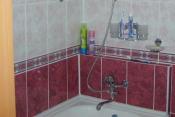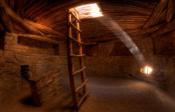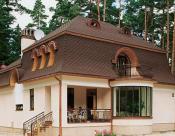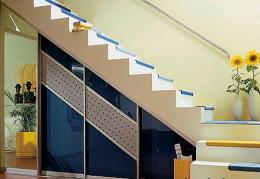Search
Login
Recommended
Built-in wardrobe under the stairs in a private house, options for the built-in wardrobe under the stairs, do-it-yourself installation
Space for storage is constantly not enough. At the same time, in any house there is a small free space that can be used to equip a built-in closet or a spacious shelving.
This time we will focus on the rational use of empty space under the stairs. What cabinet options can be placed under the stairs, and is it realistic to install built-in furniture yourself? Let's try to figure it out.
Content
- Rational use of space under the stairs video
- Options for built-in wardrobes under the stairs
- Tips for arranging and equipping the cabinet under the stairs
- DIY installation of a built-in cabinet under the stairs
Rational use of space under the stairs
Owners of small private houses sometimes encounter the problem of placing stairs, looking for options for the most convenient and compact installation. After all, often marching stairs are located in the hallway, where in addition to the incoming door there are two or three doors from other rooms of the house.
To make up for the missing storage space, some craftsmen try to somehow use and use the empty space under the stairs.
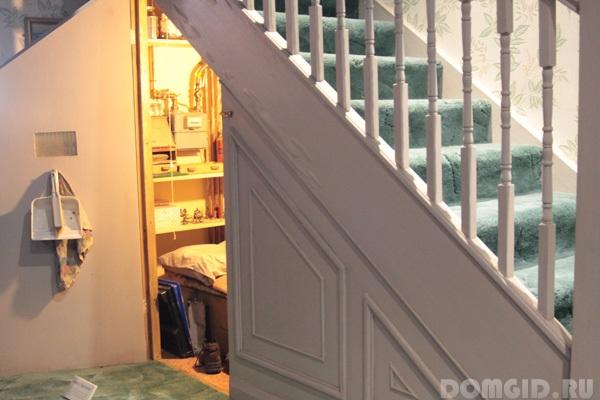
If space allows, then you can build a room under the stairs. It can be a place for relaxation (corner sofa), a children's corner, a study or a kitchenette.
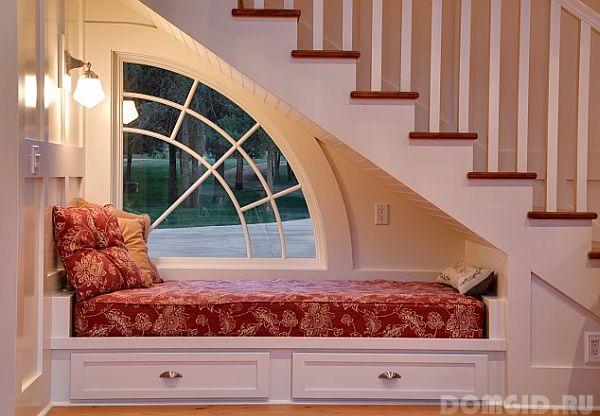
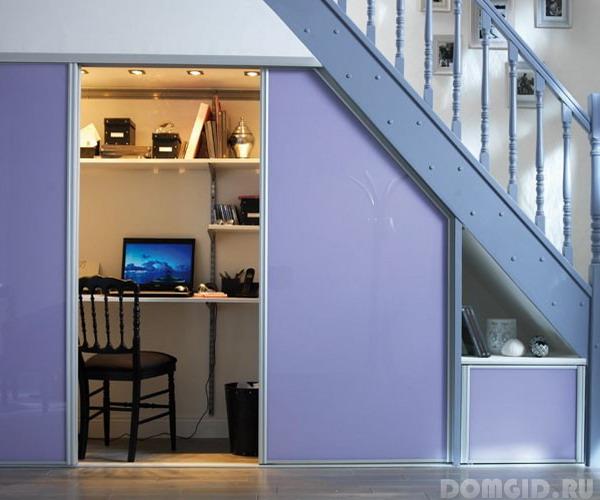
There are a lot of ideas for arranging the undercostal space. It all depends on the imagination, the desire of the owners of the house and the size of the room. If desired, under the stairs, you can organize: a wine cellar, a flower greenhouse, place a fireplace, an aquarium, a chest of drawers, an artificial pond, equip a minibar or install a piano.
Among all options for the rational use of the stairwell, the most common and practical arrangement of the cabinet in the house under the stairs. An improvised wardrobe turns out to be quite roomy, because its depth will be equal to the width of the flight of stairs. Here you can organize a dressing room, make a pantry for off-season things, arrange an open hallway or a closet for storing small folding furniture, sledges, skis, children's bicycles or blanks for the winter.
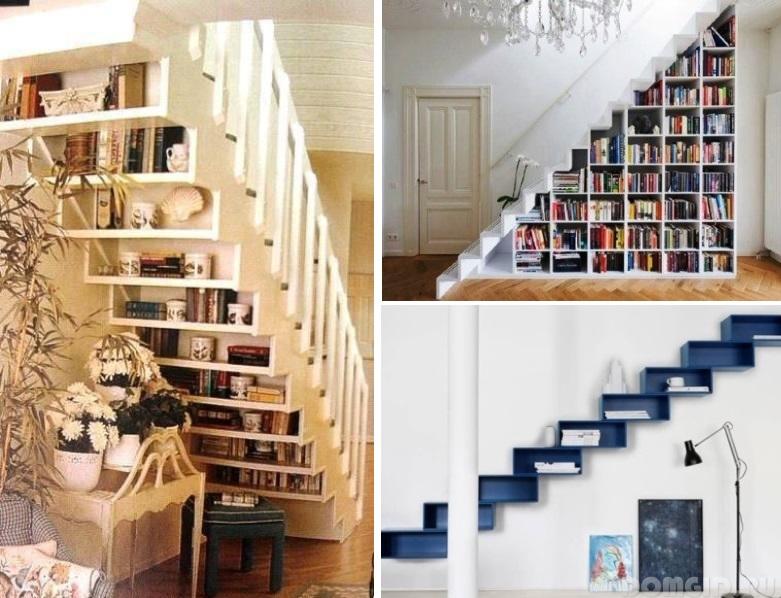
It should be noted that the interior of the house with the advent of a built-in wardrobe under the flight of stairs becomes augmented and more harmonious. In order for the cabinet to be useful and consistent with the general appearance of the room, it is necessary to choose the optimal type of built-in design that will allow you to efficiently operate free square meters.
Options for built-in wardrobes under the stairs
Sliding wardrobe maximum saving of space
The wardrobe under the stairs will harmoniously look against the background of any interior. A variety of external furniture finishes (mirrored doors, photo printing or original, exquisite painting on the closet) allows you to design and practically equip the hallway, children’s room, living room or bedroom.
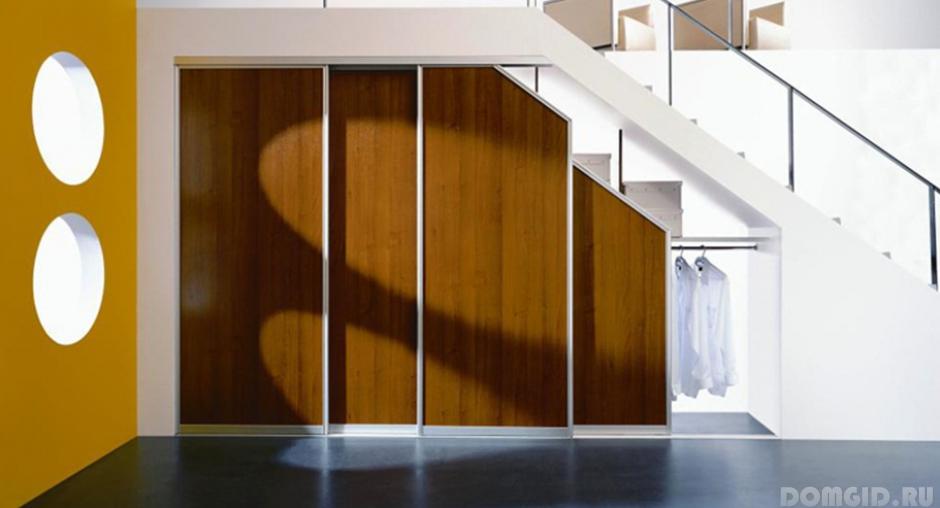
The built-in wardrobe is especially recommended for use in small rooms; they will save the space needed to open swing doors. In addition, this cabinet is very spacious and uses the entire space under the stairs (you can install mezzanine shelves).
Typically, a sliding wardrobe under a staircase is combined with other types of cabinets, since the movement of sliding doors along the rails can be limited by the slope of the staircase.
Wardrobe with hinged doors the best solution for the entrance hall
If the staircase is near the entrance doors, then an interesting option for using the space under it is the arrangement of the hallway. It is better to make a cabinet with hinged doors, and the design itself can have disparate elements or act as an integral composition.
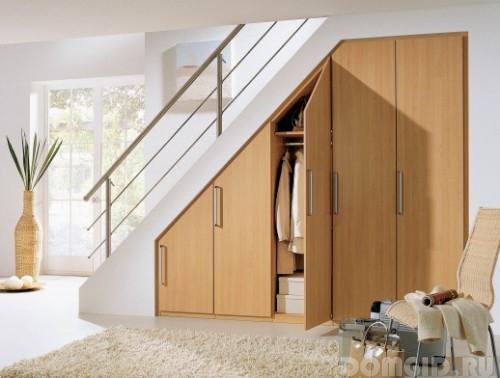
It is not necessary to occupy all the space under the stairs under the closet for the hallway. They should take a small part (from the bottom of the stairs) so that not only adults, but also children can get to the shelves.
Departments of the cabinet should be equipped with hangers, hooks, and also equip a shelf for storing hats, scarves. A convenient padded ottoman, coasters for slippers, umbrellas and a key keeper will look appropriate near the cabinet. Be sure to provide a roomy department with shelves for seasonal and non-seasonal shoes.
The remaining part under the stairs can be used as a pantry (you can do without mounting shelves) for a vacuum cleaner, mops, buckets, children's toys for the street and various household equipment.
Outdoor shelving practical decoration of the back of the steps
An original design solution that can beat the stairwell space, hide the back of the steps and add a functionally useful place is the arrangement of open shelving.
In addition, this type of cabinet under the stairs with your own hands is much easier to do than other options for built-in furniture. It is enough to mount a set of home-made shelves to get an interesting, practical and decorative element of the interior.
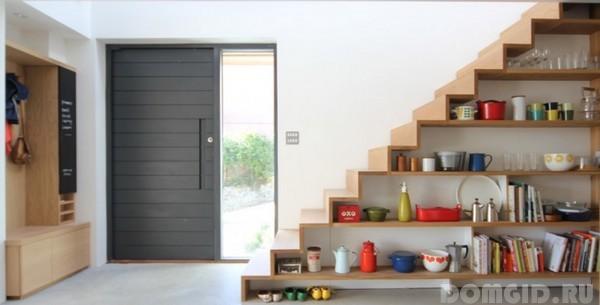
Open shelving is perfect for homes with modest dimensions. Of course, storing clothes, shoes on such shelves will be inconvenient, but memorable souvenirs and favorite photographs will add more comfort, warmth and originality to the atmosphere of the house.
You can arrange a home library under the stairs. Shelves, racks in an open cabinet should duplicate the step of the steps and go parallel with them. An unusual effect can be achieved if you perform steps and shelves in the same color scheme. However, if you want to focus on the built-in furniture, the shelves of the cabinet can be painted in a contrasting color with the steps.
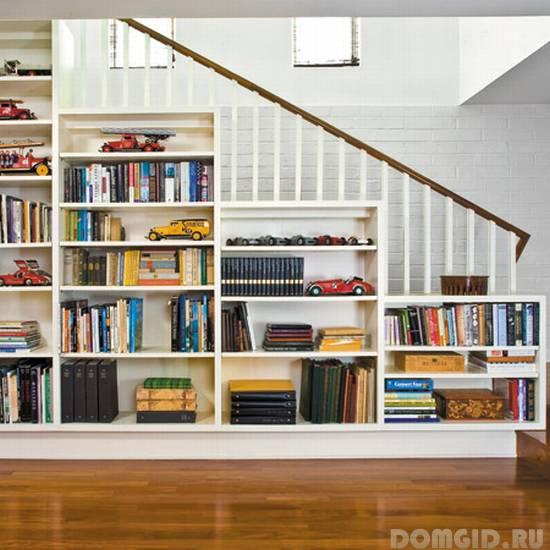
Near such a staircase you can put a cozy reading armchair or a guest sofa. If the place allows you to equip the working area with a table and a computer.
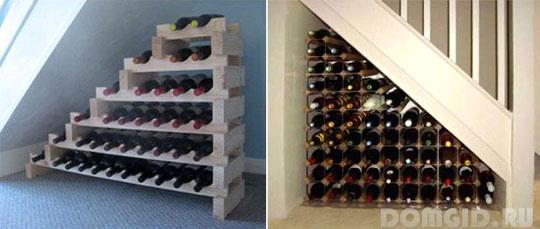
An open rack with small shelves can be used to store wines. This approach is especially liked by gourmets and lovers of the drink of the Gods.
Drawer and its varieties
The design of the drawers is suitable for storing documents, tools and other not too voluminous things. This applies to horizontal drawers.

Due to the roller guide mechanisms, the use of boxes is very convenient and comfortable. Such drawers do not burden the interior of the room.
For the arrangement of space under oversized stairs, you can make drawers (two or three along the length of the stairs) of the vertical type, that is, not divided into separate drawers.
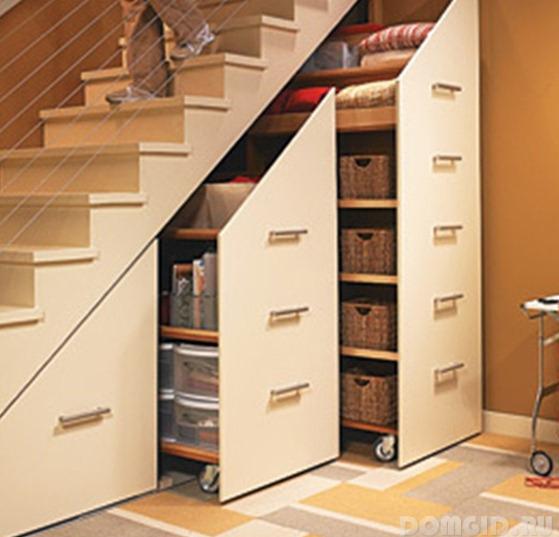
Such a cabinet leaves on special wheels that do not scratch the surface of the floor and are almost silent. If necessary, the drawer can be moved to another location. Such a cabinet is convenient to use if an exit to the pantry or other utility room, which is rarely used, is provided under the stairs.
Things in vertical drawers are usually placed on hangers or in boxes; this is necessary so that the contents of the cabinet do not fall out when moving it.
Universality of combined cabinets under the stairs
You can make a cabinet under a staircase of a combined type. This is the most convenient and functional option. In the closed part of the cabinet you can put clothes, shoes, tools, and on open shelves put decorative figurines, fresh flowers and photographs.
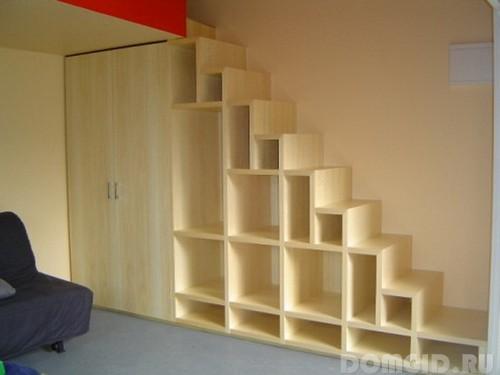
In addition to practicality, the combined cabinet also performs a decorative function. The combination of various textures and structural elements makes the cabinet a universal decoration element of any room. In the decoration of the closed part of the cabinet you can use stained-glass windows, mirrors, color films. Open cabinet racks add ease to the design and visually expand the space.
Tips for arranging and equipping the cabinet under the stairs
Getting to the solution of the main question How to make a cabinet under the stairs ?, you need to familiarize yourself with the recommendations on the configuration and arrangement of built-in staircase furniture:
- when creating a cabinet, it must be remembered that over time the number of items and things to store increases, therefore, if the financial ability allows, it is necessary to use every square centimeter of usable space;
- the main bearing element of the built-in closet of the wall of the room or the design of the stairs;
- special attention should be paid to the choice of the opening mechanism;
- the running system (door wheels) is better to choose from a material with Teflon coating or high-quality metal;
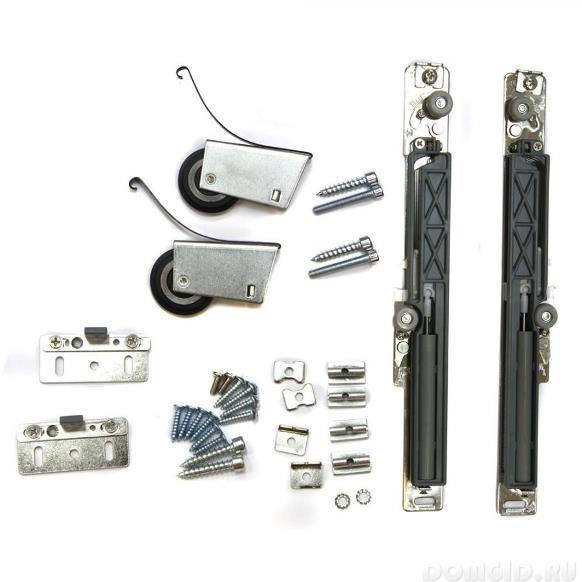
- the length of the sliding wings should not exceed one meter, this will extend the life of the furniture fittings, and using the cabinet will be more convenient.
DIY installation of a built-in cabinet under the stairs
Preparatory phase (plan-scheme of the future cabinet, necessary tools, interior decoration)
The first step is to determine the type of cabinet, prepare a plan diagram of the planned built-in cabinet, calculate all dimensions (depth, cabinet width, number and dimensions of internal shelves, partitions and doors). All possible sizes must be indicated on the drawing.
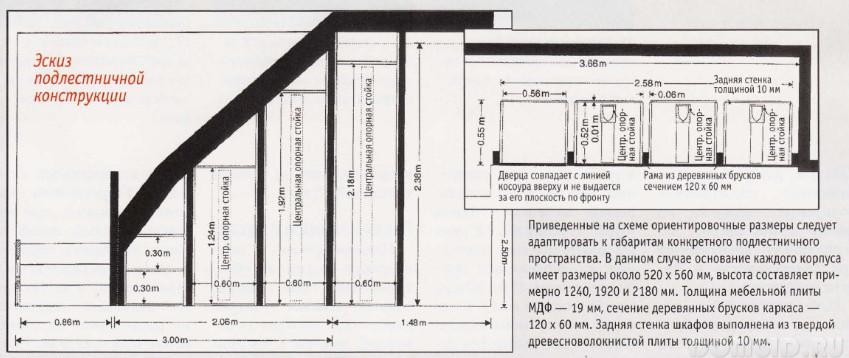
The configuration and filling of the cabinet will be determined by the size of the under-staircase, the need to store certain things (clothes, books, tools, etc.), and of course, by the designer’s imagination.
After developing a detailed scheme, you need to prepare all the necessary materials and tools:
- material for interior decoration (particleboard, paint);
- facades of drawers or doors;
- grinder, drill, hacksaw, screwdriver;
- roulette;
- bars with a section of 5 * 5 cm;
- self-tapping screws;
- accessories (canopies, handles, hooks).
Before you build the cabinet, you need to prepare the space under the stairs:
- The place under the stairs must be freed from unnecessary items. You may need to dismantle the partitions.
- Decorate the wall under the stairs. To do this, you can use: drywall, wall paneling, wallpaper or painting.
After the preliminary work is completed, you can proceed directly to the installation of the cabinet.
Sequence of installation of the built-in cabinet
Installation of the staircase is carried out in the following sequence:
- We procure cabinet parts by cutting them to the dimensions indicated in the developed drawing.
- If the cabinet will have several sections, then it is necessary to install internal partitions (the material of the partitions is drywall, MDF, particleboard, fiberboard or wooden boards).
- Mark the location of the shelves. It is important to consider that two bars will hold one shelf (the length of each bar is equal to the depth of the niche).
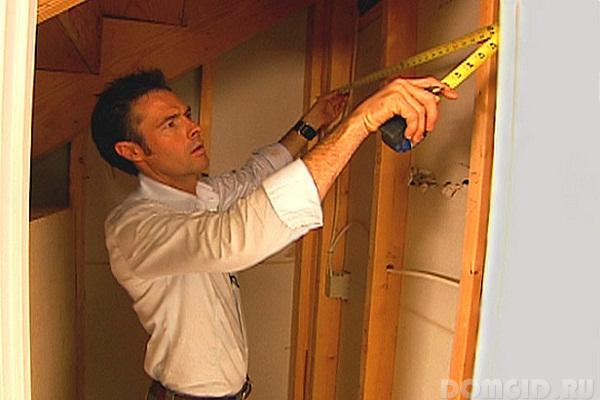
- In the places of marking, it is necessary to attach the bars with screws.
- Prepared shelves can be installed on bars (for greater reliability, they can be connected with self-tapping screws).
- Use a screwdriver to secure the door frame. It is better to order it from specialists, since without the skills of carpentry it is difficult to achieve the right joints and perfectly even angles.
- Hinges must be installed on the door frame.
- Harvested door facades must be hung on hinges.
For self-installation, it is better to use swing doors; they are the easiest to install. The installation of sliding systems is best entrusted to professionals
The final stage of installation (exterior decoration)
After completion of installation work, you can experiment with the decorative finish of the built-in cabinet. From the inside, the walls of the shelves and the cabinet can be painted the same color or glued with a self-adhesive film under a natural tree.
The color scheme must be selected in accordance with the interior of the room. The traditional white color is a classic option, but if there are children in the house, then it is better to choose a less soiled color for the cabinet.

Stairs with drawers can be decorated with handles that complement the style of the surrounding furniture. It would be nice to supplement the place near the cabinet with suitable accessories: a hanging mirror, flowerpots with flowers, a comfortable ottoman or a small armchair.
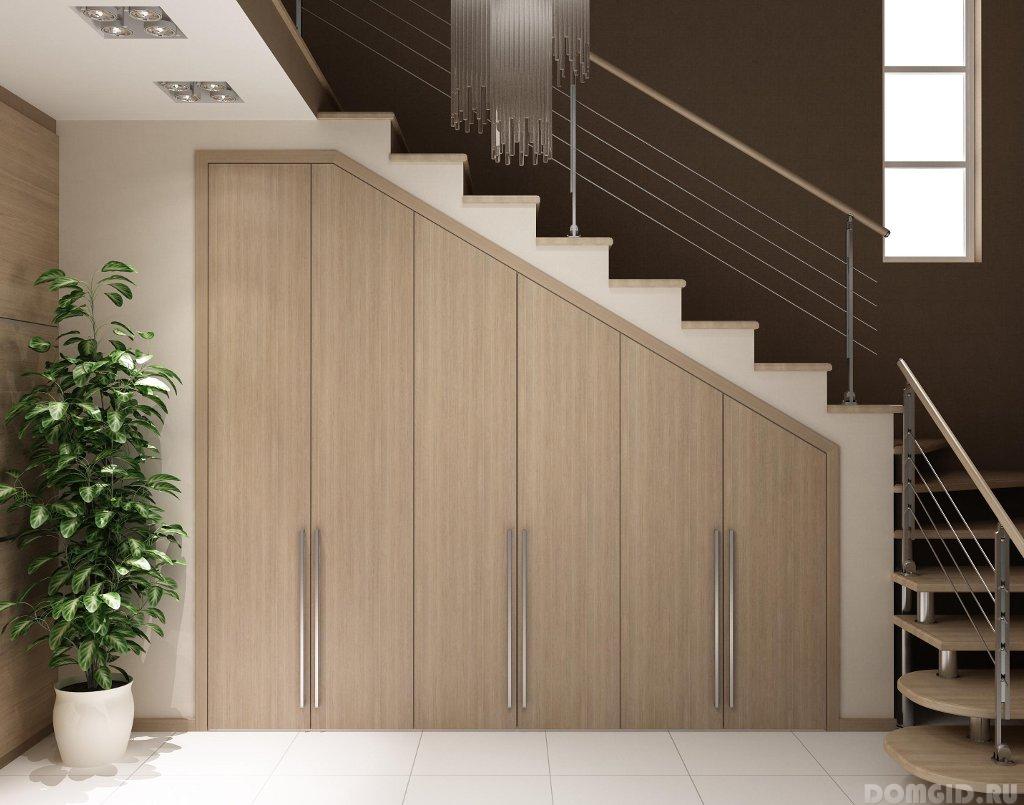
The empty space under the stairs can be quickly, and without significant costs, turned into a neat, convenient and roomy closet in which you can place a variety of things. You can create such a cabinet with your own hands, but at the difficult stages of installation you should not refuse the help of professionals.
